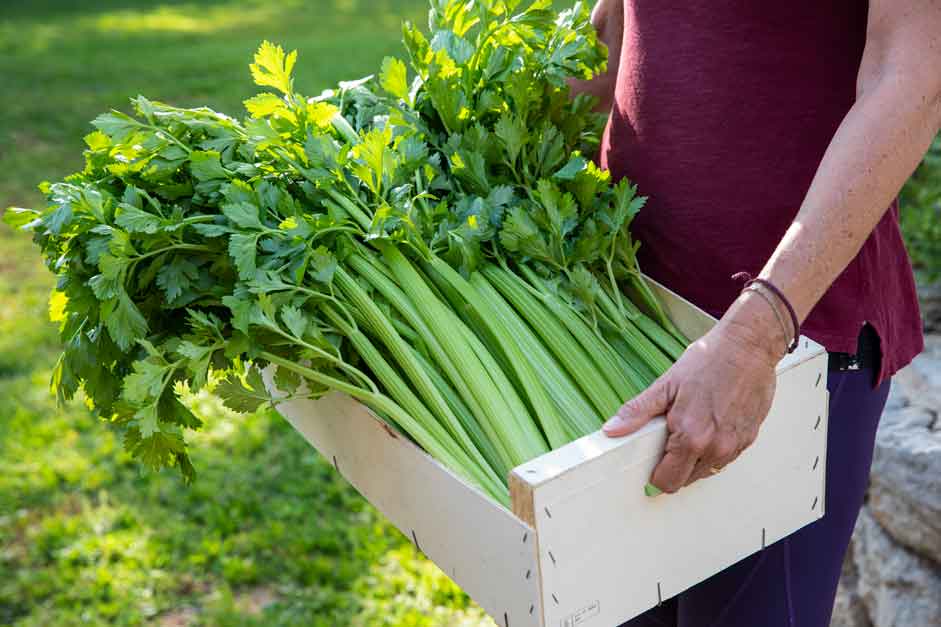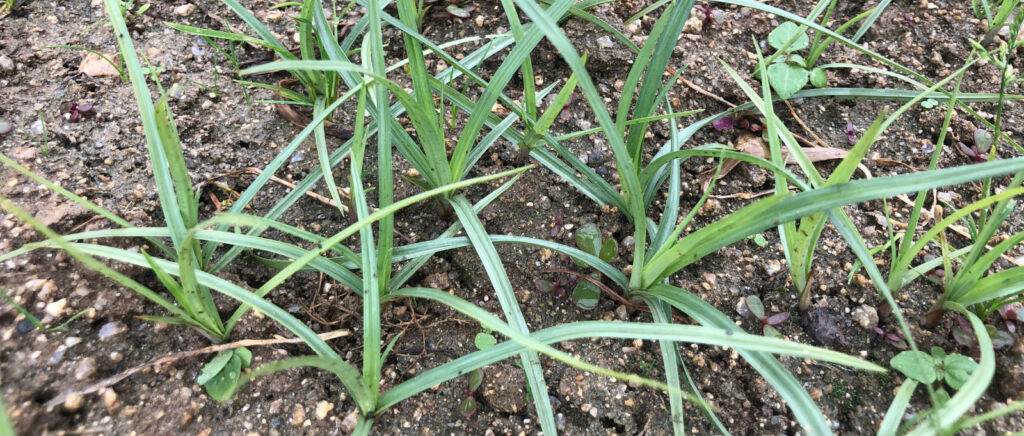Welcome back to our Novamulch agricultural section. This time, we’ll explore how to grow celery. A unique plant, with its many uses since ancient times, highly valued today in local and international markets, its agronomic characteristics and agricultural requirements merit study and analysis. Let’s take a detailed look at how to grow celery, integrating it into sustainable agriculture and achieving excellent marketing levels.
Historical background of celery. Ancestral origin.
Apium graveolens, better known today as Celery, Spanish Celery, Celery, Sedano, among others, has a thousand-year-old origin, from Ancient Egypt and the humid areas of the Mediterranean, where it was used in its wild form for rituals and ceremonies, and also as one of the essential ingredients in preparations of ancient medicine.
It is mentioned in some medical documents such as the Ebers Papyrus, dated to the 16th century BC, in which Apium was an ingredient used as a diuretic, laxative, urinary antiseptic and digestive stimulant, as well as in treatments to cleanse the blood, ease breathing, treat fevers and relieve joint pain.
On the other hand, celery was considered a sacred symbol and used in religious ceremonies and as a funerary offering. This was demonstrated by the British archaeologist and Egyptologist Howard Carter (1874-1939), who discovered the tomb of Pharaoh Tutankhamun (KV62) in Egypt, in the Valley of the Kings, in 1922.
Carter found botanical remains of garlands of leaves and flowers on a linen sheet, among which were identified wild celery leaves, as well as fruits dating approximately to the time of Tutankhamun’s reign, around 1323 BC. This discovery was an example of the symbolism represented by this plant, associated with victory, purification and fertility, typical practices of Egyptian royalty.
Celery in Ancient Greece.
The symbolic and ritual value of wild celery was of utmost importance, especially for the Isthmian Games, the four great games celebrated by the ancient Greeks in honor of the god Poseidon. They took place at the sanctuary of Poseidon on the Isthmus of Corinth, near the sanctuary of Isthmia, hence their name. At these games, the victors received crowns made of wild celery (selinon), which demonstrates the importance of this plant to ancient Greek culture.
Celery in Ancient Rome.
For the ancient Romans, celery (Apium graveolens) was highly valued and used for a variety of purposes. They ate it as a vegetable in its wild form, which was more bitter than today’s; its leaves and stalks were a highly aromatic condiment that they added to stews, soups, and sauces, and it was also included in wines and liqueurs, such as Vinum Apianum, to enhance their flavor.
Likewise, documents by Pliny the Elder, Dioscorides and Cato the Elder refer to celery as a natural remedy: as a diuretic and purifier, to stimulate the appetite and relieve digestive disorders, in preparations to calm the nerves and treat insomnia, and its seeds were used in infusions with calming and aphrodisiac effects.
In certain contexts, and as in Ancient Greece, celery had a funerary character associated with death and mourning, as it was placed in garlands and funeral wreaths, offered to the Gods, used as a purifying plant and in festivities, thus showing the double symbolic value: in the vital and in the mortuary.
Celery in the Middle Ages.
During this period, Apium graveolens, or celery, was domesticated in the regions of Northern Europe, continuing its use as a medicinal plant rather than a food.
Celery in the 17th century: varieties began to be bred here to soften the strong, bitter flavor of wild celery, and these evolved to take on the form we know today: a thick-stemmed celery with a more delicate and fragrant flavor.
Celery in the 18th and 19th centuries: during these periods, it was already cultivated for consumption in European gardens, and in France, England, and Italy, the development of the first stalk blanching techniques began, which are still practiced today to improve the texture and flavor of cultivated celery.
Celery arrived in North America in the late 18th century.
Around 1769, the New York Chronicle recommended “transplanting celery in trenches to whiten it.” The first seeds were imported from London, confirming that growing celery was already a common culinary practice by then, and it had become established commercially.
By the 19th century, celery cultivation spread widely across North America, thanks to European immigrant communities, especially Italian and German, who brought agricultural knowledge and improved varieties. One of the pioneering regions for celery cultivation was Kalamazoo, Michigan, where the soil and climate conditions were ideal. By the end of the 19th century, the area had become one of the country’s main production centers, becoming known as the Celery Capital of the World.
In the first American cookbook published in 1796, American Cookery, written by Amelia Simmons, recipes for celery appear as a side dish for main dishes, and in the early 19th century, in 1806, Bernard M’Mahon documented three cultivated varieties in The American Gardener’s Calendar.
Celery in Latin America.
In Mexico, celery cultivation began in temperate zones in the center of the country, such as the State of Mexico, Puebla, and Guanajuato. It was also used as a traditional medicinal plant, taking advantage of its digestive and diuretic properties.
In Chile, during the 20th century, and especially in the central region of the country, celery cultivation became part of intensive agriculture and is currently a regular part of the vegetable rotation system.
In Argentina, celery cultivation developed in regions such as Buenos Aires and Mendoza, expanding to domestic and export markets.
From the 20th century to the present day, growing celery is a high-value agricultural activity in the American market. This vegetable is a daily part of healthy diets and is a highly valued ingredient in broths, creams, green juices, and salads, making it a highly commercially valuable product in supermarkets and specialty stores.
Agronomic characteristics of Celery.
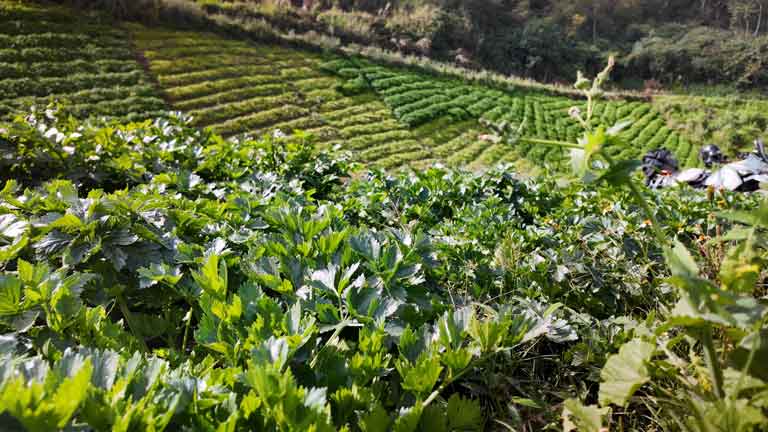
This is a long-cycle vegetable belonging to the Apiaceae or Umbelliferae family (its flowers are arranged in umbels, umbrella-shaped structures with numerous radial peduncles emerging from a common point). This is one of the most important groups of flowering plants in the plant kingdom, like parsley, fennel, and carrots.
Let’s study its morphology if we want to learn how to grow celery within a more complete framework.
Primary root: This is a robust, central root that grows vertically downward from the seed, providing a deep anchor and highly efficient resource absorption. It is the main axis of the root system, from which smaller, lateral secondary roots emerge. In varieties such as celeriac, the root enlarges, forming an edible bulb.
Stem: This is not a typical stem like that of other plants. It’s actually a thickened petiole, the part of the stem that supports the leaf. However, botanically, it’s known as a stalk. Its shape and structure allow it to be crisp, firm, and yet flexible and efficient at transporting sap. This makes it the crucial plant element for the plant and for consumption.
Leaves: Deep green, compound. The outer leaves are larger, while the central leaves protect the growth bud.
Inflorescence: an umbel composed of small, greenish-white flowers. The umbel is a type of inflorescence, a specific shape in which flowers are grouped on the plant. In umbels, the flowers arise from a common point toward the end of the flower stalk, and each flower is supported by a separate stem or pedicel, creating its characteristic flat or slightly convex shape. This is distinctive of the Apiaceae family, such as celery, parsley, fennel, cilantro, and carrots. This structure makes these vegetables very attractive to pollinating insects and helps identify them botanically.
Fruit: Oval and flattened. When ripe, it divides into two mericarps, or reproductive units designed to protect the seed and disperse it naturally.
More information about celery at this link:
https://es.wikipedia.org/wiki/Apium_graveolens
What varieties can we choose to grow celery?
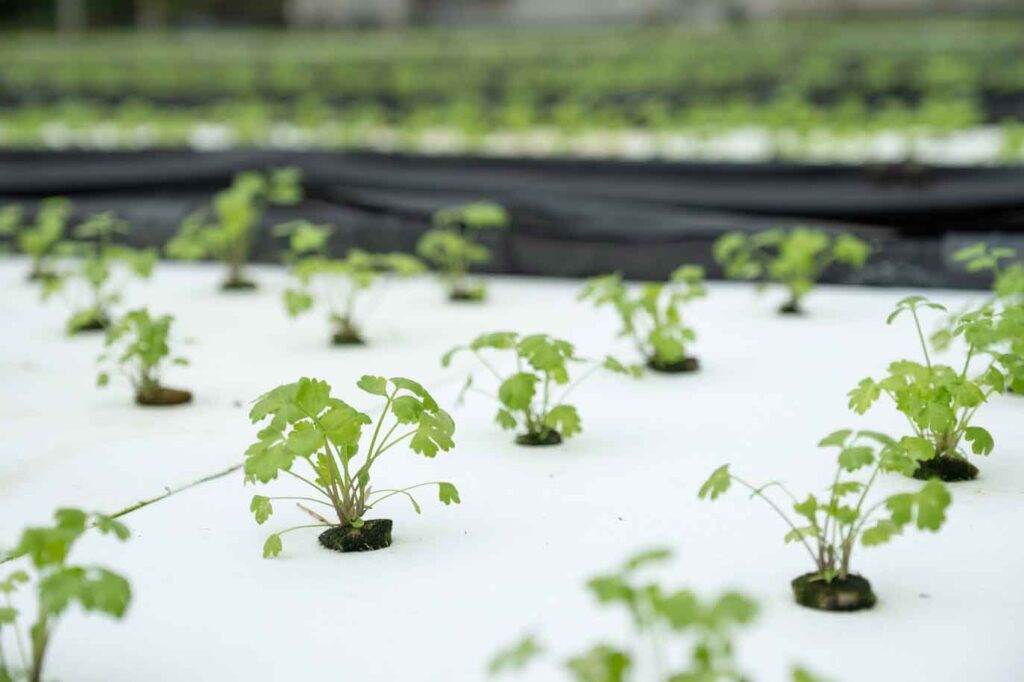
This is where we’ll make decisions. Which variety to select depends on the conditions in which we’ll be growing celery, the type of environment we have available, and the climatic conditions and irrigation capacity of our growing area.
Furthermore, by developing a well-thought-out roadmap in advance, we can diversify our production and easily adapt to market demands or our domestic consumption needs.
First, let’s analyze the three main groups of varieties and which ones are most commercially available.
Celery (Apium graveolens var. dulce).
This variety is perhaps the most popular due to its blanched form. Its stems are elongated, thick, and fleshy, its green, aromatic leaves are eye-catching, and it adapts easily to cultivation both in open fields and in smaller spaces. Blanching the leaves softens the flavor and enhances the color.
What do we call whitening?
It’s an agricultural technique that partially deprives plants of sunlight to reduce chlorophyll production, thereby modifying their color, texture, and flavor. This results in paler, more tender leaves and stems with a milder, less bitter flavor.
What are the most common whitening methods?
We start this between 2 and 3 weeks before harvesting our celery, when the stalks have reached a sufficient length.
Hilling: As the leaves grow, we pile up the soil around them and partially cover them.
Cover with opaque material: It is highly recommended to cover the leaves with biodegradable paper mulch to achieve healthier and more effective results for the plant during this bleaching process.
Traditional method: Trench cultivation. Here we plant celery in deep trenches, gradually filling them in to cover the stalks.
Blanching is highly recommended to improve the agronomic characteristics of celery while following an organic approach. We will obtain a more tender, crispy, and delicately flavored crop, making our production more marketable, healthy, and attractive to our consumers.
Most notable varieties of stalk celery.
Tall Utah: Very popular for its mild flavor and crisp stems. Good bolting resistance.
Golden Pascal: crecimiento vigoroso y tallos amarillentos después del blanqueo.
Golden Pascal: vigorous growth and yellowish stems after bleaching. Conquistador: early, ideal for warm climates, with smooth, uniform stems.
Green Giant: a robust, high-yielding variety, widely cultivated in intensive agriculture.
Celeriac or Celeriac (Apium graveolens var. rapaceum).
This variety is highly aromatic and prized in the Central European market for its thick, spherical root, ideal for adding to purées, stews, and gourmet dishes. The foliage is shorter than that of leaf celery, but very similar, and its cultivation requires a long cycle and deep soils.
Here we present some of the most common varieties.
Brilliant: large, white, firm root with good storage capacity.
Prinz: compact, early, smooth flavor.
Ibis: easy to peel and widely grown in organic farming.
Here we show a very entertaining video about the Celeriac variety.
Leaf celery or cutting celery (Apium graveolens var. secalinum).
This species is also highly prized and frequently cultivated for its aromatic foliage, which can be used as a condiment, either fresh or dried. It does not develop thick stems or thickened roots, making it very effective as a culinary and medicinal plant. Its cultivation adapts easily to small areas and is ideal for staggered harvesting.
Popular varieties of this species.
Amsterdam Cutting: very fine leaves and fast growth.
Delicato: more compact, with intense flavor.
Par-Cel: a hybrid between celery and parsley, highly appreciated in gastronomy.
Choosing the variety of celery according to use and climate.
Let’s analyze the varieties according to the destination we have planned for our agricultural roadmap.
Purpose of cultivation: for fresh consumption.
Recommended variety: Tall Utah and Green Giant.
Characteristics: long, crispy stems.
Purpose of cultivation: for gourmet cooking.
Recommended variety: Brilliant and Prinz.
Characteristics: round, white root.
Purpose of cultivation: as a condiment.
Recommended variety: Amsterdam Cutting and Par-Cel.
Characteristics: fine leaves and intense aroma.
Cultivation purpose: suitable for warm climates.
Recommended variety: Conquistador.
Features: resistant to bolting.
Purpose of cultivation: suitable for organic farming.
Recommended variety: Ibis and Delicato.
Characteristics: good adaptation and excellent flavor.
Recommended climatic requirements for growing celery.
Apium graveolens is a vegetable native to temperate climates and requires specific climatic conditions to develop its full potential. Since it is sensitive to extreme temperatures, it will be necessary to conduct a detailed prior review of the required conditions regarding temperature fluctuations, if any, humidity, and sun exposure in the area or environment where we have chosen to grow celery.
Here we show the conditions required for high-quality, high-yield crops: moderate temperatures without fluctuations, between 15°C and 21°C, and no lower than 5°C, as this will slow growth. If temperatures rise to 25°C or higher, they will induce bolting and premature flowering, which is not recommended.
During the germination phase, temperatures should be maintained between 18°C and 22°C. At this stage, temperatures up to 25°C or higher will produce fibrous, bitter stems with reduced vegetative development. For young seedlings, the habitat we need to control is quite delicate, as temperatures below 10°C will cause premature bolting and ruin our harvest. During the early stages of planting, we should avoid temperatures of 10°C or lower to avoid accelerating flowering and to induce it at the appropriate time.
Let us briefly study the following table of climatic factors:
Grow celery in temperate to humid climates. Recommendations: Suitable for cultivation. Allows for long cycles and high yields.
Grow celery in warm to dry climates. Recommendations: Select heat-resistant varieties. Water frequently and use biodegradable paper mulch to maintain adequate moisture.
Growing celery in cold climates. Recommendations: Avoid transplanting during frost. Grow under tunnels or greenhouses in areas at risk of bolting outside the normal crop cycle.
Grow celery in areas subject to strong winds and adverse weather conditions. In these regions, celery can dehydrate its foliage and burn its leaves. In the event of heavy and frequent rainfall, fungal diseases proliferate if drainage and ventilation systems are not properly managed. It is very important to use natural barriers and windbreaks here, especially if we are growing celery in the open field.
How to grow celery in different environments? Soil preparation and proper nutrition for each situation.
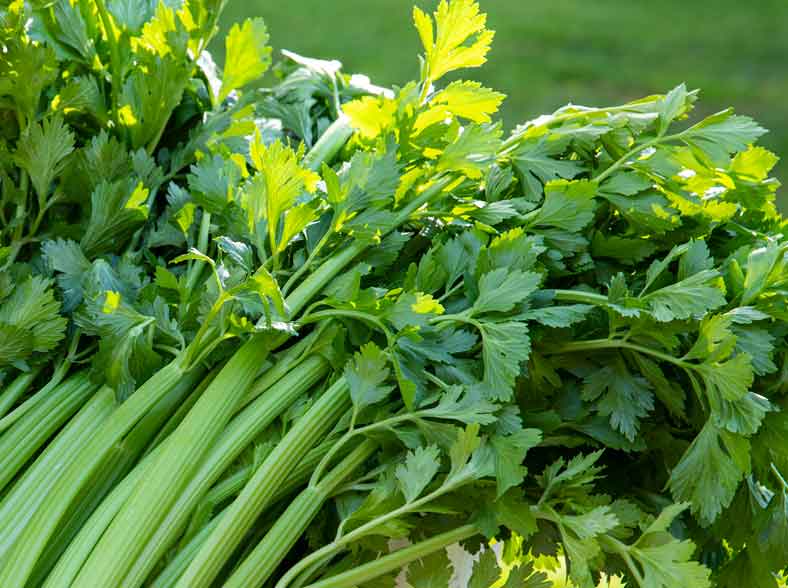
To successfully carry out our celery growing plan, it is essential to create a roadmap in which we design, in detail and step by step, all the events that will follow one another. This includes the environment we have, soil preparation, rotations or amendments that should be made if we are going to “grow on already cultivated soil,” as well as the use of biodegradable paper mulch to ensure the overall health of the entire process, the application times of organic nutrients and fertilizers, harvest times, storage, and, if applicable, the distribution or transportation of our product. This information illustrates the appropriate methods for growing celery.
Beneficial associations for growing excellent quality celery.
We suggest you review some articles we’ve published in our Novamulch agricultural space, and below are two links to help you learn how to combine compatible plants and improve your production.
Cultivar Tomates. Un emprendimiento muy productivo y enriquecedor.
Plantar pimientos, 16 recomendaciones para incorporar técnicas sostenibles y rentables.
¿Cómo plantar ajos aplicando técnicas agrícolas modernas?
Let’s start by growing celery in the open field.
This agricultural practice is very common in temperate climates and is recommended in cool, humid microclimates, especially during spring and fall.
The selection of the growing area will determine, among other variables, the quality of the final product. Therefore, it is essential to locate an area with easy access to an efficient irrigation system and the possibility of receiving direct, but not excessive, sunlight, between 4 and 6 hours daily.
Celery needs constant moisture, and biodegradable paper mulch plays a crucial role in this, controlling and maintaining adequate moisture throughout each growing phase. It also inhibits and prevents not only waterlogging and leaching, but also the emergence and proliferation of weeds such as sedge.
It’s important to note that the water used for irrigation should be as low in salinity as possible because celery is sensitive to salt buildup. Therefore, the soil we have prepared for growing celery should be deep, with good drainage, a slightly acidic or neutral pH between 6.0 and 7.0, and a high level of organic matter.
We show you how to grow celery in the open field:
The texture of the soil.
This means that the relative proportion of mineral particles such as sand, silt, and clay can be: Sandy loam (loose, well-drained, with sufficient water retention capacity). Silt loam (ideal for fertile soils with good nutrient retention). Loamy (balanced between sand, silt, and clay, with good water exchange capacity and stable structure).
What soil textures should we avoid?
- Pure sandy soil (drains water and nutrients quickly, low retention capacity and fertility).
- Compact clay (retains too much water, causes waterlogging and root asphyxiation).
- Stony (prevents uniform root development and makes crop management difficult).
What precautions should we take into account regarding the characteristics of the terrain when growing celery in the open field?
- Avoid soils where other umbelliferous species such as carrots, parsley, and cilantro have been grown previously or recently to prevent the buildup of specific pathogens.
- We recommend areas that have been fertilized with organic compost and without recent use of synthetic herbicides or pesticides.
Types of tillage most suitable for growing celery in open fields.
Celery is a vegetable that requires specific agronomic and agricultural conditions. Its root system is relatively shallow, so it’s important to grow these crops in loose, deep, and well-aerated soils, as we’ve already discussed. Tillage plays a crucial role in loosening the soil and breaking up compaction.
If we select an appropriate method to till our soil, we will obtain the following benefits.
- We will make root development much easier.
- We allow proper water infiltration and retention.
- We promote the quality of gas exchange and microbiological activity.
- We will remove any plant debris and residual weeds to begin planting or transplanting more safely.
- We facilitate the incorporation of organic matter and other ecological fertilizers.
Let’s now study the different types of tillage suitable for growing celery.
Deep tillage or subsoiling.
Subsoiling involves tilling below the traditional plowing level, at depths of approximately 30 to 60 cm, without turning over the soil in areas with subsoil compaction or in heavy clay soils. This helps break up hardened layers, improve drainage, and promote deep root development.
Primary tillage or turning (plowing).
It’s done at a depth of between 25 and 35 cm, and this method eliminates the remains of a previous crop, especially in those where initial weed control is required. This prepares the soil for regular planting work.
Secondary processing (refining).
This is done at a depth of 10 to 20 cm, using disc harrows or a rototiller to break up any remaining clods after plowing the soil. This aims to achieve a fluffy, even texture, ideal for transplanting celery.
Raised beds or ridges are recommended, especially for soils with poor drainage capacity, as this will prevent waterlogging and promote root system aeration. It also helps achieve targeted irrigation.
When do we incorporate the first nutrients?
We’ll do this during the second stage of tillage. We’ll add well-rotted compost, vermicompost, or ground green manure. This will improve the soil quality for our organic celery crop.
What alternatives do we have for reduced or sustainable tillage?
These are minimal or conservation tillage practices. By using hand tools or tillers, we can reduce tillage intensity to preserve microbial life. We promote regenerative agriculture, reduce erosion, and conserve topsoil.
How can we know if our soil is suitable for transplanting or sowing celery?
We will do a series of pre-tests and take notes:
- If a handful of moist soil crumbles easily when you take it, this will be the right structure.
- If it forms hard or plastic balls, our soil has excess clay.
- If it runs through your fingers and doesn’t hold together, we’ve added too much sand.
How can we improve soil texture and structure to grow celery with optimal results?
We’ll incorporate organic matter such as compost, worm castings, or composted vegetable manure. In all cases, they must be well-rotted, loose, and dry.
- We recommend using biodegradable paper mulch to protect the prepared soil and improve its biology.
- We will avoid trampling and compacting; we should not work our soil if it is excessively moist.
- We can practice rotations with crops that improve the nature of the soil, such as legumes or green manures.
Disinfecting the soil for growing celery in the open field.
Celery, in particular, is a plant sensitive to common soil-borne diseases. If we want to achieve a robust, healthy, and long-lasting crop, the most viable solution is to prepare and maintain the soil with nutrients and fertilizers similar to it: natural, ecological, and organic.
Otherwise, we would be forcing and aggressively modifying it, and sooner or later we will see the results of using products that, while it is true that they eliminate pests and diseases in record time, and we can obtain voluminous and very attractive harvests in the eyes of our consumers, in the long run the level of deterioration will be felt and perhaps beyond recovery.
For all these reasons, when we need to disinfect the soil where we are going to grow celery or another vegetable, we must be responsible and aware of the products we will use, not only to eliminate residues from previous crops or remnants of pests and diseases that can reproduce successively, but also to nourish and strengthen our soil with elements that can biodegrade and replenish it for future plantings.
Natural, physical, and biological methods reduce the presence of pathogens, nematodes, and weed seeds without harming the biodiversity of the soil ecosystem.
The objectives we expect when carrying out ecological disinfection are:
- Reduce the load of pathogenic fungi (such as Fusarium, Pythium, Rhizoctonia).
- Reduce the population of plant-parasitic nematodes.
- Eliminate remaining and predictable weed seeds without using herbicides.
- Improve the microbiological balance of the soil before sowing or transplanting.
We can biofumigate with fresh organic matter. We incorporate organic matter rich in sulfur compounds, such as brassicas (mustard, turnip, rapeseed), alfalfa, or fresh green compost.
We spread and cover the soil with biodegradable paper mulch to retain the gases released during anaerobic fermentation. We let it do its job for about 15 to 30 days.
This will generate volatile natural compounds (such as isothiocyanates) that suppress fungi, bacteria and nematodes, while also improving soil structure and making it much more fertile.
Another natural method is to apply beneficial microorganisms.
These microorganisms are the following:
- Trichoderma spp.: is antagonistic to pathogenic fungi.
- Bacillus subtilis: strengthens the defense of the root system.
- Arbuscular mycorrhizae: stimulate nutrient absorption and protect against potential root stress.
Application form:
- Including them in irrigation or including them in the compost or substrate material.
- After solarizing or biofumigating the soil (with green manure), this is done to encourage the reactivation of beneficial microorganisms such as bacteria, fungi, actinomycetes, algae, and protozoa, which inhabit the soil ecosystem and perform essential functions for healthy plant development and ecological balance.
Let’s always keep in mind that a soil rich in this microbial life will be much more fertile, healthy, resilient, and productive. It is the foundation of regenerative organic agriculture, as it allows for the reduction of external inputs and fosters a balanced natural ecosystem.
We can also disinfect our soil by letting it rest, adding green fallow (a temporary, fast-growing, biodegradable, and natural nutrient cover that improves soil fertility, protects it from erosion, and encourages its natural regeneration, instead of leaving it completely bare or unproductive), with beneficial plants such as legumes, which regenerate the soil microbiota.
How do we do organic fertilization in open fields to grow celery?
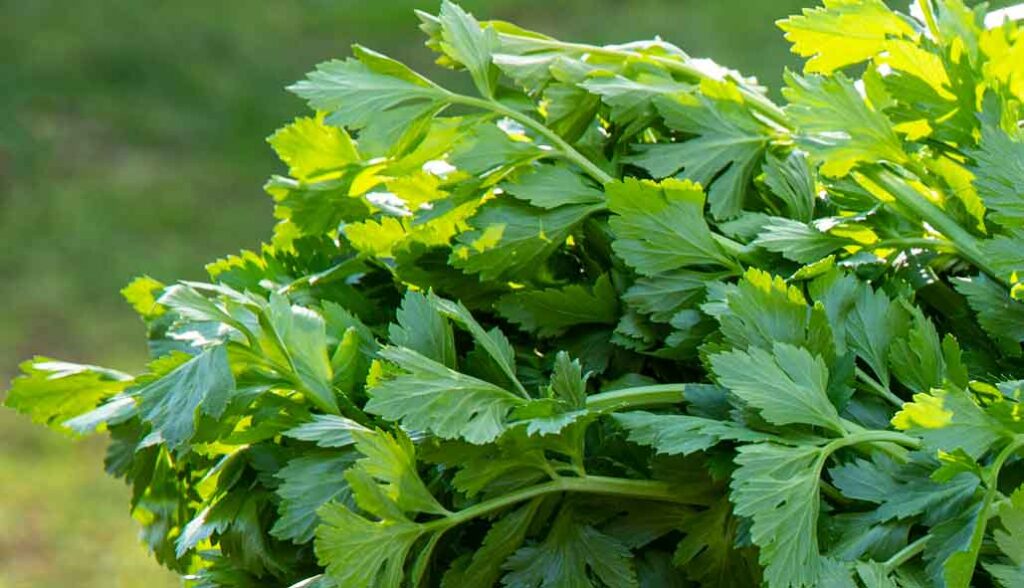
Here we present several inputs and practices.
Base organic matter:
- It is essential to improve soil nature, water retention and fertility.
- We add mature vegetable compost, made from well-decomposed plant remains.
- Vegetable Bocashi, which is fermented compost with effective microorganisms.
- Peat moss or composted coconut fiber: these amendments help maintain moisture and aeration, and by implementing biodegradable paper mulch, we will reinforce this function.
- Activated biochar: improves nutrient retention and stimulates microbial life.
Phosphorus (P) contributions:
- To grow celery, it is a determining element to promote initial root development.
- Ground natural phosphate rock: as a source of slow and prolonged release.
- Vegetable ash from legumes: containing traces of phosphorus and other minerals.
- Basalt flour: rich in trace minerals and long-term available phosphorus.
Potassium (K) contributions:
- It is essential to allow the formation of strong stems, organoleptic quality and resistance to water stress.
- Sifted wood ash: rich in potassium, calcium and trace elements.
- Langbeinite: natural rock rich in potassium and magnesium, accepted in organic farming.
- Seaweed meal or dry seaweed extract: improves crop strength and vigor.
Calcium and magnesium (Ca and Mg) contributions:
- They are crucial for achieving firmness of the leaves and for preventing physiopathies such as apical necrosis.
- Dolomitic lime: a natural source of calcium and magnesium. It also regulates soil pH.
- Basalt powder: This mineral amendment improves soil structure and gradually releases minerals.
- Natural zeolites: improve cation exchange capacity and calcium availability.
Biological amendments and biostimulants.
They promote microbial life in the soil and improve nutrient assimilation.
Oxygenated vegetable compost tea, which stimulates the beneficial microbiota of the soil.
Fermented nettle or comfrey extract, essential for strengthening the plant’s metabolism and activating its natural defenses.
Effective microorganisms such as Lactic acid bacteria (such as Lactobacillus spp.), Photosynthetic bacteria (such as Rhodopseudomonas spp.), Yeasts (such as Saccharomyces cerevisiae), Actinobacteria (such as Streptomyces spp.), Beneficial fungi (such as Trichoderma spp. and mycorrhizae), which we can add incorporated into the compost or bocashi to enrich it before application, diluted in water (1:100 or depending on the product), and applied by irrigation or spraying to the soil days before transplanting, or as oxygenated compost tea in the form of a root bath or activating irrigation.
Growing celery in a greenhouse.
In protected spaces like a greenhouse, we are more likely to be able to grow celery under controlled climate conditions, with more uniform, healthy, and higher-quality growth. Celery is less exposed to temperature fluctuations, frost, excessive rainfall, or drought, and is less likely to be affected by pests and diseases, as long as we keep a log throughout the planting process.
Preparing the soil for growing celery in a greenhouse.
The requirements we’ve already discussed in this agricultural section regarding proper soil preparation for growing celery in the open field apply equally to all other environments. However, let’s review what we’ve covered:
It’s advisable to achieve a balance between water retention capacity and adequate aeration, such as preventing waterlogging and allowing the root system of our plants to expand. To achieve this, we need loamy or sandy loam soil that’s light, deep, loose, and well-drained. We also need light, shallow tillage to preserve the soil’s microbiota.
We are going to enrich the soil with organic matter such as mature vegetable compost, made from pruning remains, crop residues and leaves, vegetable Bocashi (we have already analyzed its composition), activated Biochar, so that we can increase the cation exchange capacity and nutrient retention, and vegetable peat or composted coconut fiber which is very important for poor or very sandy soils.
We adjust the pH between 6.0 and 7.0, and in the case of an overly acidic soil, we can correct it with organic dolomitic lime as a natural source of calcium and magnesium, sifted vegetable ash that in addition to raising the pH, provides potassium and micronutrients, and we will avoid the use of pH correctors of animal origin (such as eggshell or bone meal).
Oxygenated plant compost tea will allow us to inoculate beneficial microorganisms. Effective microorganisms will be very favorable for strengthening the structure and bioavailability of nutrients, and fermented nettle and comfrey extracts will stimulate microbiology and strengthen the plant from its early stages of growth.
Once this soil preparation step is complete, we can spread biodegradable paper mulch to protect the structure we’ve already formed. We can begin to establish a stable, continuous moisture pattern that will prevent waterlogging, inhibit the growth of weeds like sedge, and protect the crop from potential temperature fluctuations, even within the greenhouse.
During cultivation, remember to provide oxygenated compost tea, fermented extracts of nettle, comfrey, and horsetail, which are rich in micronutrients, strengthen tissues, and stimulate growth, and liquid solutions of seaweed as a natural source of potassium, growth regulators, and trace elements. Don’t forget infusions of fermented green fertilizers such as oats or legumes for advanced vegetative cycles.
Growing celery in home and urban gardens.
These environments are a rewarding way to produce fresh, pesticide-free food, as well as an opportunity to share with family and our immediate community.
What are the basic conditions for growing celery in home and urban gardens?
Let’s analyze this report.
- Light: We need at least 4 to 6 hours of direct sunlight daily.
- Temperature: It adapts very well to temperate climates, between 15 and 21°C.
- Suitable containers: Celery can be grown in deep pots, planters, or growing tables, as long as they have good drainage.
In this video, we learn how to build and layout garden beds for our urban and home gardens.
Soil or substrate preparation:
Ideal texture: We use a light, loose, and airy substrate that retains moisture well and is not prone to waterlogging, as we’ve already seen. The growing tray should have drainage holes. At the bottom, we place a layer of gravel or expanded clay, 50% topsoil, 30% compost, and 20% coconut fiber or perlite. Before planting, we add mature compost, worm castings, or composted manure to enrich the substrate.
Let’s have on hand:
- Organic or slow-release fertilizers.
- Macronutrients (Nitrogen (N): compost tea, liquid humus, nettle slurry, Phosphorus (P): wood ash in small quantities, Potassium (K): wood ash, comfrey extract, organic liquid fertilizer rich in K.)
- Micronutrients (Calcium, magnesium and boron: ground eggshell, dolomite, natural mineral solutions.
- Beneficial associations: We can plant our celery near onions, leeks, or lettuce, as they won’t compete for root space and are natural pest repellents.
Growing celery in pots.
This is a practical, aromatic, and effective option that we can use in our homes, as this versatile vegetable adapts well to growing in containers approximately 30 cm deep and 25 to 30 cm in diameter, with several holes in the bottom. We should position the containers so they receive direct sunlight for 4 to 6 hours daily.
The recommended soil mix is 50% quality topsoil (preferably peat-free), 30% mature compost or worm castings, and 20% aerating material such as perlite, coconut fiber, or coarse sand. Before sowing seeds or seedlings, we should provide sufficient organic matter, as nutrients are easily depleted in these containers. Remember to keep a log of measurements and monitoring to maintain the quality of our planting.
During the growing process, we’ll add the rest of the organic nutrients, as previously mentioned, after measuring them. (Compost tea, nettle slurry, balanced liquid NPK fertilizer, fermented plant extracts such as alfalfa, nettle, or comfrey, liquid humus, small doses of sifted and pulverized wood ash, and organic foliar fertilizers to prevent leaf yellowing.)
It is important to remove dry leaves or leaves with abnormalities such as spots or yellowing, so that our celery can concentrate its energy on producing robust stalks and leaves.
In this sample, we can obtain celery seeds from the same plant. Let’s see.
Grow celery on terraces and balconies.
This vegetable adapts easily to this and any other type of environment, even though it is a demanding plant in terms of water and nutrients. However, by constantly monitoring the planting time, we will achieve a healthy, robust, and very attractive harvest. In this case, we need direct sunlight for 5 to 6 hours daily, and in very hot areas, we should implement partial shading during the hottest hours.
If our terraces and balconies are exposed to prolonged or occasional strong winds, we recommend installing windbreaks or placing plants under tunnels of mesh and ecological material to protect them. The areas should be 30 cm deep so that the root system can fully develop. Keep in mind that in these cases, nutrients are also depleted quickly, so we should take measurements and keep on hand those that have been absorbed to maintain a balanced soil and good crop quality. Watering should be frequent and moderate, and we should avoid both soil dryness and waterlogging.
Proper maintenance for growing celery.
When designing our agricultural roadmap for growing celery, we must always keep in mind that these vegetables are susceptible to variations in water and nutrition, as well as the changing nature of the soil. Therefore, it is essential to keep a log to monitor and control all the stages of our planting.
We need a stable irrigation system, preferably drip irrigation, to avoid direct contact of water with the leaves. Here, biodegradable paper mulch plays a key role, maintaining balanced humidity throughout the process and controlling weed growth.
Every 10 to 15 days, we will apply vegetable compost, organic liquid biofertilizers such as fermented nettle extracts, comfrey, or compost tea, and we will constantly monitor the development and structure of the leaves: their color, firmness, and growth, in order to respond if any abnormalities arise.
Fertigation is also essential for these crops, as these activated preparations maintain the vitality and proper biological activity of the soil.
Organic plant extracts, such as garlic infusion, horsetail, and potassium soap, are excellent preventative treatments for the appearance of pests and diseases.
When required, we will whitewash the soil by placing biodegradable paper mulch or hilling it with compost, maintaining adequate ventilation to prevent moisture buildup, especially when growing in small spaces and greenhouses.
Biodegradable paper mulch is necessary for growing celery in any environment.
Paper mulching is an advanced and sustainable agricultural technique, an agronomic necessity, and today it is an indispensable tool for protecting and preserving all types of crops and environments, from open fields to small spaces.
Biodegradable paper mulch is specifically designed to act as a physical barrier, inhibiting the emergence and growth of weeds like the dreaded sedge. It’s a great way to assist us if we have celery growing on our roadmap.
It reduces water and nutrient evaporation, maintaining adequate humidity levels at all times, allowing us to significantly reduce costs.
It protects plant structure because, when spread over the soil from the beginning of seed sowing or transplanting, paper mulch prevents the fruit and leaves from coming into direct contact with the soil, thus preventing irreversible damage and the growth of harmful fungi and bacteria. Celery growing list.
Paper mulch biodegrades and becomes an essential nutrient for enriching the soil with plant organic matter, which is essential for subsequent crops.
Buy Novamulch biodegradable paper mulch here to grow your celery.
-
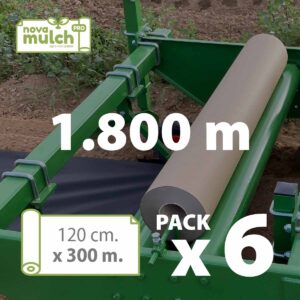 PACK of 6 rolls of Novamulch Professional paper 120 cm. x 300 m. (1.800 m)565,28 € IVA incluido
PACK of 6 rolls of Novamulch Professional paper 120 cm. x 300 m. (1.800 m)565,28 € IVA incluido -
 PACK of 3 rolls of Novamulch Professional paper 120 cm. x 300 m. (900 m)282,22 € IVA incluido
PACK of 3 rolls of Novamulch Professional paper 120 cm. x 300 m. (900 m)282,22 € IVA incluido -
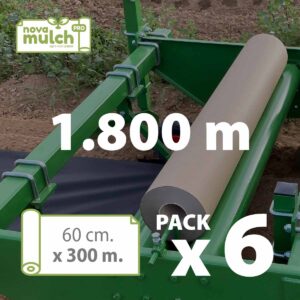 PACK of 6 rolls of Novamulch Professional paper 60 cm. x 300 m. (1.800 m)282,22 € IVA incluido
PACK of 6 rolls of Novamulch Professional paper 60 cm. x 300 m. (1.800 m)282,22 € IVA incluido -
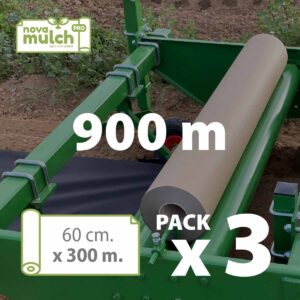 PACK of 3 rolls of Novamulch Professional paper 60 cm. x 300 m. (900 m)141,30 € IVA incluido
PACK of 3 rolls of Novamulch Professional paper 60 cm. x 300 m. (900 m)141,30 € IVA incluido -
 Novamulch Professional Paper 120 cm. x 300 m.94,21 € IVA incluido
Novamulch Professional Paper 120 cm. x 300 m.94,21 € IVA incluido -
 Novamulch Professional Paper 60 cm. x 300 m.47,10 € IVA incluido
Novamulch Professional Paper 60 cm. x 300 m.47,10 € IVA incluido -
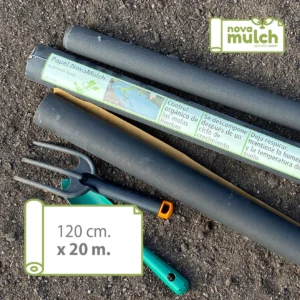 Novamulch paper 120 cm. x 20 m.41,63 € IVA incluido
Novamulch paper 120 cm. x 20 m.41,63 € IVA incluido -
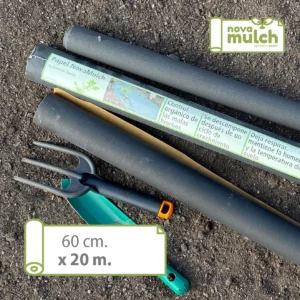 Novamulch paper 60 cm. x 20 m.21,89 € IVA incluido
Novamulch paper 60 cm. x 20 m.21,89 € IVA incluido -
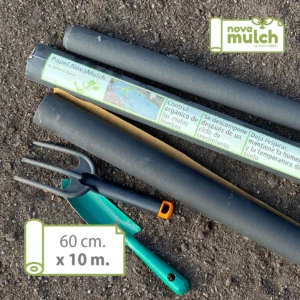 Novamulch paper 60 cm. x 10m.14,85 € IVA incluido
Novamulch paper 60 cm. x 10m.14,85 € IVA incluido -
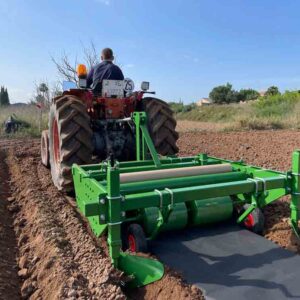 Novamulch agricultural mulching machine
Novamulch agricultural mulching machine
Let’s now examine the ecological advantages of paper mulch versus plastic mulch.
It is 100% biodegradable, compostable, leaves no polluting residue as it is made from natural cellulose fibers, and is suitable for all types of sustainable, ecological, and regenerative production, such as celery cultivation.
Furthermore, paper mulch respects the natural cycles of the agricultural ecosystem. It is perfectly compatible with certified organic farming practices.
It reduces dependence on petroleum-derived polymers.
By biodegrading, it increases microbial activity in the soil, and unlike plastic (which causes exudation and suffocation of the soil and root system), paper mulch allows for proper respiration and aeration, preventing compaction and leaching, regulating humidity, and inhibiting the growth of weeds and fungi.
Plastic material is an excellent breeding ground for the proliferation of sedge, as it allows it to grow robustly. When it passes through the plastic material, it invades and spreads throughout our crop.
It can be installed manually or with adapted machinery, just like plastic mulch. It can be perforated or slotted to fit any growing frame. Its effective lifespan varies between 3 and 7 months, depending on the climate and irrigation.
What are the benefits of using biodegradable paper mulch to grow celery in a variety of environments? Let’s review.
- In open fields, tilling becomes much easier, making drip irrigation very efficient and safe, and reducing inputs.
- In a greenhouse: it maintains a constant balance of soil temperature, reduces diseases caused by excessive humidity, and improves the root environment.
- In home and urban gardens: it completely controls humidity levels, helps keep the entire crop very clean, and forms a harmonious and aesthetic part of the entire agricultural context. Let’s remember that this is an important detail for our nearby communities and potential local consumers.
- On terraces, balconies, and in pots: paper mulch is very convenient for these containers and containers, to prevent dryness and compaction of the soil and substrates, and also promotes the hygiene of our crops.
Why is biodegradable paper mulch especially important for growing celery?
This vegetable requires special care throughout its growth process. Its surface root system must be constantly monitored to keep it free of weeds and balanced within the appropriate humidity and temperature levels. For this, we use biodegradable paper mulch, our protective and stabilizing agent; it also prevents the onset of water stress. At the end of the crop, we will find that our harvest will be of superior quality.
Celery harvest and storage times.
These timings must be as precise as possible to achieve robust, beautifully colored, well-developed, and sweet-tasting stalks. Harvest time can vary depending on the variety, weather conditions, cultivation techniques, the environments we’ve set up for planting, and how we’ve managed each stage of growth up to this point: the harvest. Let’s analyze these timings.
From the moment we sow the seeds, we estimate it will take approximately 120 to 180 days to harvest the crop. If we transplant, we estimate it will take between 70 and 100 days, depending on the variety we choose.
If we live in areas with mild spring climates and need to harvest our celery between the months of June and August, we should transplant it during March and April.
In regions with mild autumns, we will transplant during August and September, and harvest between November and December.
If we choose to grow celery in a greenhouse, we will have the advantage of being able to stagger production and advance or extend our harvests.
What indicators should we take into account to determine the right time for harvesting?
When the celery reaches a height of between 30 and 60 cm and the stalks are well developed, vertical, thick and firm, light green in color without spots or yellowish tones, or a whitish tone, if it has been blanched.
The stems should have a crisp texture, not fibrous or overly soft, and the central bud should be closed or barely open. If the plant is in the initial flowering phase, harvest immediately.
If we have planted in home gardens or small plots, we can stagger harvests, cutting the most developed plants and allowing the smaller ones to continue their development.
When growing celery commercially or on a large scale, it is advisable to harvest in one or two stages, depending on the degree of uniformity observed in our crop.
Harvesting celery in open field.
What are the best times to harvest?
Early morning and late afternoon are perfect times. It’s very important to avoid harvesting during high sunlight exposure, as the heat can dehydrate the stems and affect their texture.
Proper storage for celery.
Let’s now study the most appropriate storage method to keep our celery in excellent condition after harvesting.
Let’s now study what is the most appropriate storage to keep our celery in excellent condition after harvesting it. Let’s keep in mind that celery is a highly perishable vegetable due to its high water content, the delicate structure of its stalks, its sensitivity to dehydration and ethylene emission, and all this requires convenient storage to maintain quality and prolong its shelf life as much as possible.
Let’s look at some essential steps we need to implement.
Immediate handling after harvest.
Avoid mechanical damage when separating the stalks. Cut them gently with a sharp, disinfected knife, avoiding tearing the structure.
Immediately move the harvest to a shaded area.
We will remove any damaged or yellowed outer leaves and gently shake off any adhering soil.
The appropriate temperature for storing them ranges from 0° to 2°C, with a high relative humidity of 95° to 100°C, and we must provide a ventilated and shaded area to prevent condensation and mold. Ethylene emission is irreversible for celery, so we should not store it in the same area as apples, bananas, and tomatoes.
Storage in refrigeration or cold room.
To store these vegetables commercially and in large volumes, we will use cold storage or refrigerators. We will keep our harvest clean for 3 to 4 weeks, placing them in well-ventilated plastic boxes or perforated containers. This way, they will not lose their freshness and can be stored in proper conditions.
Storage in domestic refrigerator.
If we have harvested our celery in home gardens, urban gardens, or in smaller spaces, it is advisable to wrap the stalks in a damp cloth or use a perforated paper bag and store them in the vegetable drawer for about 7 to 10 days.
Here we also present some useful tips that can be of great help to us:
- Do not wash celery before storing it if you are not going to consume it immediately.
- Let’s avoid excess surface moisture to prevent the appearance of mold.
- Do not freeze celery as it loses texture and softens when defrosted.
Common pests and diseases to consider before growing celery.
Celery, as we have mentioned, is a vegetable susceptible to pests and diseases that can compromise its quality and yield.
The habit of keeping a road map or a crop log, in which we periodically note all the events that occur during the planting process, such as nutrients added at each stage, pruning and soil amendments, monitoring of humidity and irrigation levels, results in root, leaf, and flower development, and dates of appearance of the first fruits, as well as the gradual growth of the structure of each plant.
It’s a good idea to create a list of daily events to clearly define our farming record, ensuring we can monitor and manage both these events and any unforeseen events that may arise.
Let’s study the common pests of celery.
Aphids (Aphis spp.).
Small, green, black, or brown insects that congregate on the underside of leaves and young shoots. They feed by sucking sap, causing deformed leaves, curling, and general weakening of the plant.
Damage:
They transmit viruses. They excrete honeydew, which promotes the growth of sooty mold (black mold).
Ecological control:
- Natural predators: ladybugs, lacewings, hoverflies.
- Nettle extract or potassium soap as a foliar treatment.
- Crop rotation and elimination of nearby host plants.
Leaf miners (Liriomyza spp.).
Small flies whose larvae burrow into the interior of leaves. They are detected by irregular white lines running across the leaf surface.
Damage:
They reduce photosynthetic capacity. They weaken the plant and facilitate secondary infections.
Ecological control:
- Yellow chromatic traps to capture adults.
- Removal of affected leaves.
- Promotion of natural enemies such as Diglyphus isaea (parasitoid wasp).
Celery fly (Euleia heraclei).
Mosca específica del apio y otras umbelíferas. Las larvas excavan galerías visibles en los pecíolos y hojas.
Damage:
Weakened stems with watery, brown areas. Decreased commercial value.
Ecological control:
- Early harvesting of affected plants.
- Crop rotation and use of insect netting.
- Introduction of natural parasitoids if locally available.
Thrips (Frankliniella occidentalis, Thrips tabaci).
Tiny, elongated insects that scrape plant tissue. They prefer warm, dry environments, common in greenhouses.
Damage:
Silvery or whitish spots on leaves. Deformities in young leaves.
Ecological control:
- Increase the humidity in the environment.
- Blue sticky traps.
- Foliar applications with neem extract or garlic infusion.
Gray or cutworms (Agrotis spp.).
Moth larvae that remain in the ground during the day and feed at night.
Damage:
They cut seedlings at the base, causing losses in the crop implantation phase.
Ecological control:
- Placing protective physical collars around the stem.
- Application of Bacillus thuringiensis (Bt) if larval population is detected.
- Keep the soil aerated and free of decomposing plant debris.
Let’s analyze common diseases in celery cultivation.
Due to its high water content and growth in humid conditions, celery is prone to various fungal, bacterial, and physiological diseases. These diseases can affect the commercial quality of the stalks, reduce yield, and, in extreme cases, completely destroy the crop. To avoid this, we recommend planning detailed prevention measures, diagnosing any potential problems early, and using natural and cultural methods to prevent their spread.
Septoria wilt of celery (Septoria apiicola).
Cause:
Fungus that affects leaves, especially in conditions of high humidity and low ventilation.
Symptoms:
- Rounded, light brown to greyish spots with a dark border.
- They develop first on the lower leaves and move upwards.
Ecological prevention and control:
- Crop rotation with non-umbelliferous species.
- Avoid excessive sprinkler irrigation and maintain ventilation.
- Preventive applications with horsetail extracts or organic wettable sulfur.
Mildew (Peronospora spp.).
Cause:
Oomycete that thrives in cool, humid climates, especially in poorly ventilated greenhouses.
Symptoms:
- Yellow spots on the upper surface of the leaves, with a kind of greyish mould on the underside.
- Loss of vigor and rapid spread if not controlled.
Ecological prevention and control:
- Improve ventilation in the crop.
- Avoid nighttime or excessive watering.
- Foliar treatments with an infusion of garlic, horsetail, or organic potassium bicarbonate.
Bacterial soft rot (Erwinia carotovora).
Cause:
Bacteria that infects through wounds or mechanical damage, favored by excessive humidity.
Symptoms:
- Watery, soft stems with an unpleasant odor.
- It appears mainly at the base of the plant and extends towards the leaves.
Ecological prevention and control:
- Avoid excess humidity and puddles.
- Harvest carefully, without damaging the plants.
- Do not store wet or damaged celery.
Leaf blight (Cercospora apii).
Cause:
Fungus that mainly affects leaves in warm and humid climates.
Symptoms:
- Small, angular, grayish spots on the leaves.
- It can be confused with septoria in its early stages. Septoria is a fungal disease that primarily affects the foliar system of many plant species, including vegetables such as celery (Apium graveolens), tomatoes, and cereals.
Ecological prevention and control:
- Removal of infected plant debris.
- Improved drainage and ventilation.
- Foliar treatments with natural biofungicides such as nettle extract or fermented compost.
Apical necrosis (physiological disease).
Cause:
Calcium deficiency in young tissues, associated with humidity fluctuations or nutrient imbalances.
Symptoms:
- Darkening of the apex of the petioles, followed by soft, collapsed tissues.
- It appears in stages of rapid growth.
Ecological prevention and control:
- Regular intake of organic calcium (ground eggshell, dolomitic lime).
- Uniform, constant and controlled irrigation, avoiding alternating drought and over-irrigation.
- Avoid excess nitrogen, which competes with calcium in the plant.
Celery diseases can be serious if not detected early, but with well-planned organic management, they can be prevented and controlled with effective results. It’s essential to take notes to address essential tasks at the right time, such as crop rotation, soil disinfection and amendments as needed, humidity control, adequate ventilation, the use of natural preparations, and strengthening the soil with the right nutrients. These steps are crucial to keeping our crops healthy and productive.
Final thoughts.
In our agricultural section today, we studied how to grow celery. However, we opened up to the opportunity to connect with a vegetable that carries a profound symbolic and ritualistic, medicinal, and culinary significance.
Initially appearing in nature as wild celery, it has been highly valued by various civilizations since its ancient origins, all of which have allowed this continuous learning of cultivation to reach our days as an expression of agriculture spread throughout the planet.
Today, we can grow celery in large areas or even in pots, and in all environments we receive great satisfaction and productivity, which we can sell or share with our loved ones.
Following our roadmap, we’ve learned that growing celery is a living process that requires observation, patience, and perseverance. It’s part of one of the key models of organic farming, where biodegradable paper mulch plays a vital role as an indispensable agent for clean agronomic practices and for ensuring the balance, health, and excellent quality of this and any other crop we may undertake.
This is why we are all committed to agriculture today and tomorrow, resilient, sustainable, and in total harmony with nature.

